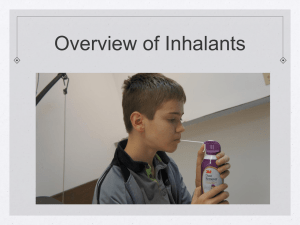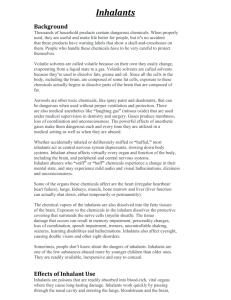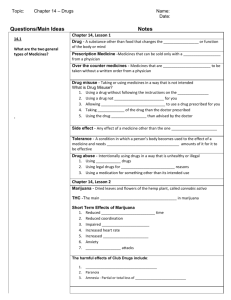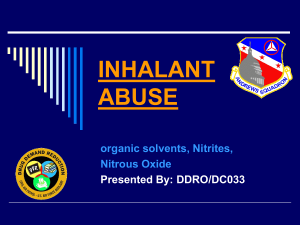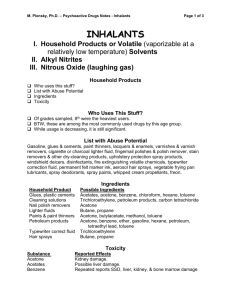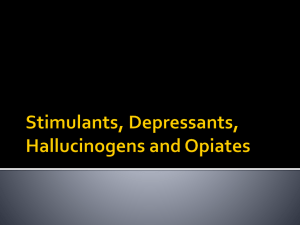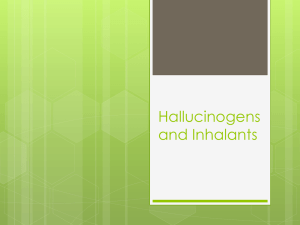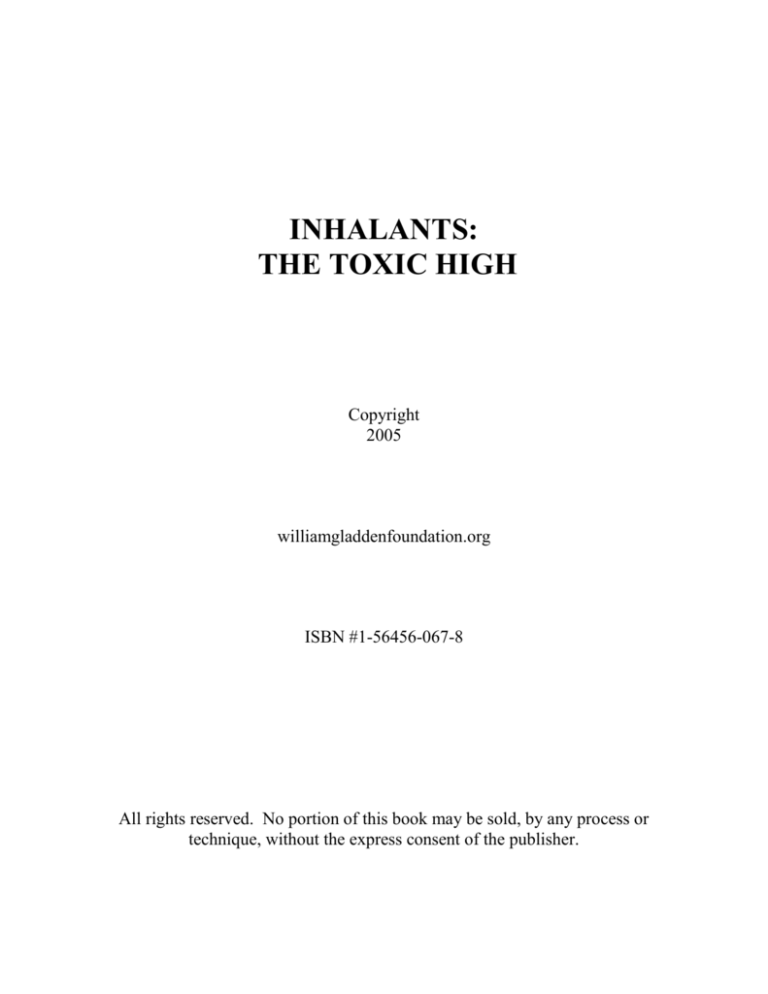
INHALANTS:
THE TOXIC HIGH
Copyright
2005
williamgladdenfoundation.org
ISBN #1-56456-067-8
All rights reserved. No portion of this book may be sold, by any process or
technique, without the express consent of the publisher.
INTRODUCTION
The use of inhalants for inducing intoxication is an old practice. Many ancient cultures
attempted to predict the future by having soothsayers sit over fissures in the earth from
which escaped natural gases. As they inhaled these fumes, and stupor developed, the
intoxicated soothsayers were supposed to foretell the future.
Although there is evidence that inhalation of intoxicating vapors was part of several
ancient cultures, the use of “inhalants” in modern American society took root during the
1960s and 1970s. Still a part of the drug culture, use of inhalants declines for a while and
then rises.
Inhalants are any substance that gives off vapors capable of generating an intoxicating
“high.” They are in many common household products and manufactured chemicals.
Adolescents are the primary users of inhalants. This may be because they are easily
accessible, often being readily available at home or a nearby store. Evidence suggests
that nearly 20% of American high school students have tried “sniffing,” with the majority
being middle-school students. Additionally, both sexes in all social and economic classes
and in all geographic regions of the United States use inhalants.
Although figures on inhalant use are inexact, it appears that most users do so only once or
twice, then either quit or move on to other drugs. Habitual use occurs in about 10% of
inhalant users. Additionally, boys seem more involved than are girls, with males
accounting for about 90% of the deaths associated with inhalant use.
While there are many chemicals capable of intoxication, inhalants, in general, create a
quickly developing, intense, short-lived “high.” They are a depressant to the central
nervous system, with effects similar to those of alcohol intoxication. Inhalants adversely
affect the user’s physical and mental health. They damage vital organs such as the heart
and kidneys. Inhalants also serve as a “gateway” drug” to other types of substance abuse.
J. Frederick Garman, Ph.D.
Waln K. Brown, Ph.D.
William Gladden Foundation
-II-
TABLE OF CONTENTS
QUESTIONS AND ANSWERS
What Are Inhalants?............................................................................................................4
What Are “Snappers” and “Poppers?”……….....................................................................4
How Do Users Take Inhalants?...........................................................................................4
How Do Users Obtain Inhalants ?.......................................................................................4
Who Uses Inhalants?............................................................................................................5
Why Does Inhalant Use Decline With Age?.......................................................................5
Why Do Children Use Inhalants?........................................................................................5
What Happens When Inhalants Are Used?.........................................................................5
Are Inhalants A Health Hazard?..........................................................................................6
How Do Inhalants Affect The Heart?..................................................................................6
Are Inhalants Addictive?.....................................................................................................6
What Is “Binging?”……………………………………………………..............................6
What Are The Risks Of Using Pressurized Inhalants?........................................................7
What Are The Short-Term Physical Effects Of Using Inhalants?.......................................7
What Are The Long-Term Physical Effects Of Using Inhalants?.......................................7
What Are The Short-Term Mental Effects Of Using Inhalants?.........................................7
What Are The Long-Term Mental Effects Of Using Inhalants?.........................................8
Is Possession Of Inhalants Illegal?......................................................................................8
Is The Use Of Inhalants Illegal?..........................................................................................8
What Are Some Sources Of Help For Inhalant Users?........................................................8
DANGERS ASSOCIATED WITH USING INHALANTS………...…….…..……......9
HOUSEHOLD PRODUCTS THAT ARE INHALANTS…….………………..….…10
CHEMICALS THAT ARE INHALANTS……………………....................................11
PHYSICAL EFFECTS OF INHALANT USE………………………………..………12
MENTAL EFFECTS OF INHALANT USE……………………………………..…..14
SOURCES TO CONTACT ABOUT INHALANTS….…………….………………..15
-III-
WHAT ARE INHALANTS?
Inhalants are a group of substances whose vapors generate an intoxicating effect when
inhaled. Several types of these substances are in such common household products as
nail polish remover, typewriter correction fluid, rubber cement, model airplane glue and
flammable liquids such as gasoline and kerosene. Other inhalants include chemical gases
such as nitrous oxide (“laughing gas”), butyl nitrite, amyl nitrite and isobutyl nitrite. All
inhalants are depressants to the central nervous system.
WHAT ARE “SNAPPERS” AND “POPPERS?”
“Snappers” and “poppers” are slang names given to capsules or ampoules of amyl nitrite,
butyl nitrite. These names come from the distinct snapping or popping noise that occurs
when the capsules/ampoules are squeezed and broken and spill their contents onto cotton
surrounding the reservoir. The saturated fibers are held under the nose and inhaled.
HOW DO USERS TAKE INHALANTS?
Often referred to as “glue sniffing,” users take these substances by inhaling them from a
paper or plastic bag, breathing them from a saturated rag or handkerchief or squirting
them directly into the nose or mouth.
HOW DO USERS OBTAIN INHALANTS?
Found in many household products, users obtain inhalants at supermarkets, gas stations,
drug stores, hardware stores and cosmetics counters. Other access points include adult
bookstores, “head shops” (stores that sell drug paraphernalia), pornographic magazines
and mail order catalogs.
-4-
WHO USES INHALANTS?
Teenagers, particularly adolescent males between the ages of 12 and 15, are most likely
to use inhalants. Furthermore, inhalant use appears inversely related to academic level
and is use is less frequent as teenagers move through the high school grades. Despite
research suggesting that as many as 18.6% of high school students nationwide have tried
inhalants, inhalation of these substances declines to 2.8% as students reach their senior
year in high school. Inhalant use appears concentrated in middle school.
WHY DOES INHALANT USE DECLINE WITH AGE?
Inhalants can serve as a “gateway drug” to other types of substance abuse. That is,
inhalants tend to be used by young people in their initial “experimentation” with drugs;
probably because they are so easy and inexpensive to obtain. This early involvement
with inhalants is supported by data from a study where 31% of seventh graders who
experimented with inhalants reported doing so prior to age 11. As inhalant users grow
older and have increased access to a variety of drugs, they are likely to replace inhalants
with other substances.
WHY DO CHILDREN USE INHALANTS?
Young people use inhalants for many of the same reasons they use other substances. For
example, they may use inhalants to 1) satisfy curiosity about the substances’ effects, 2)
experience the alterations in perceptions associated with inhalants, 3) gain recognition
and acceptance from peers, 4) rebel against and challenge parental and societal
expectations or 5) escape from real or perceived problems. However, a main reason why
kids use inhalants, especially younger children, is their easy access and low cost.
WHAT HAPPENS WHEN INHALANTS ARE USED?
When inhaling these substances, the user quickly gets “high” and exhibits behaviors
similar to alcohol intoxication. However, because of the ease with which many of these
chemicals enter the body and diffuse into brain cells, intoxication often occurs more
rapidly than with alcohol. Many of these substances are absorbed into the fatty
components of neural tissue, affecting the ability of nerve cells to transmit impulses.
Additionally, inhalation of these substances interferes with gas exchange between the
lungs and blood, as well as reducing the blood’s ability to transport oxygen to the cells of
the body. Binding irreversibly to proteins and other structural cell components, inhalants
may cause cellular damage that can result in loss of potassium, and other electrolytes.
These, and other alterations of the brain and body’s chemistry, are what causes the
behaviors associated with intoxication.
-5-
ARE INHALANTS A HEATH HAZARD?
Because of their effect on the central nervous system, inhalants have the capacity to be
hazardous to the user’s health. Harm can result from 1) mechanical suffocation, as stupor
leads to unconsciousness; 2) inherent toxicity of the vapors to cells of organs such as the
kidneys; 3) rhythm irregularities in the heart, brought about by an increased sensitivity to
adrenaline; 4) risk-taking behaviors when intoxication has lowered inhibitions and
impaired mental functioning; and 5) extreme flammability of many of these substances,
creating the potential for accidental but severe burns.
HOW DO INHALANTS AFFECT THE HEART?
Many inhalants have the capacity to affect the rhythm of the heart. Resulting from oversensitization of the heart to adrenaline and the body’s “flight or fight” mechanism,
rhythm irregularities, in inhalers, are difficult to correct. Not only does this reaction last
several hours after “sniffing,” it also creates a significant risk to heath every time these
substances are used. Over 50% of the deaths associated with inhalant use result from
arrhythmias of the heart.
ARE INHALANTS ADDICTIVE?
Evidence suggests that chronic inhalers of these substances develop a physical
dependency that creates withdrawal symptoms when they discontinue use. Additionally,
delirium tremens (DTs), characterized by sweating, trembling, anxiety and hallucinations,
can accompany withdrawal. As use continues and intensifies, physiological tolerance can
develop, requiring inhalation of increasing amounts of these substances to obtain the
desired “high.”
WHAT IS “BINGING?”
Inhalants enter the blood and travel to the brain, creating a fast “high,” that also can wear
off quickly. These reactions lend themselves to “binge-use,” making the intoxicating
effect last up to 12 hours through periodic “sniffing” of the intoxicating chemicals.
-6-
WHAT ARE THE RISKS OF USING PRESURIZED INHALANTS?
Some intoxicating substances come in pressurized containers. If squirted into the mouth,
the abrupt change in air pressure in the lungs can damage or rupture pulmonary tissue,
causing a “pneumothorax” (a condition where air escapes into the chest cavity, making
breathing difficult and putting additional strain on the respiratory system). Some of these
substances are “cryogenic.” That is, when released from their containers, they escape at
temperatures below freezing. When inhaling cryogenics, users have a substantial risk of
developing cold injuries or freezing the larynx or tissues of the lungs.
WHAT ARE THE SHORT-TERM PHYSICAL EFFECTS OF USING
INHALANTS?
Inhalants often produce dizziness and lightheadedness, a sense of excitement and
physical aggressiveness (which may relate to lowered inhibitions and poor judgment).
Additionally, they generate a feeling of warmth and loss of motivation. While many
users of inhalants consider these effects desirable, they may also suffer nausea, vomiting,
increased salivation and coughing. Although initial responses may be energizing,
inhalants are a central nervous system depressant that ultimately slows bodily functions,
affecting muscular coordination, speech patterns and respiration.
WHAT ARE THE LONG-TERM PHYSICAL EFFECTS OF USING
INHALANTS?
Chronic abusers of inhalants may experience loss of appetite and reduction in body
weight, ulcers in the tissues of the mouth and nose, numbness in fingers and toes, loss of
the ability to focus the eyes (resulting in double vision), dizziness and a disruption in the
sense of balance. Additionally, habitual “sniffing” of gasoline and kerosene can result in
chronic upper respiratory infection and the onset of lead poisoning. The toxic effects of
many inhalants may also cause blood abnormalities, chromosome damage and
irreversible harm to the kidneys, liver, heart and lungs.
WHAT ARE THE SHORT-TERM MENTAL EFFECTS OF USING
INHALANTS?
Short-term mental effects of using inhalants may include a sense of euphoria, loss of
inhibition and giddiness. However, after this initial “high,” confusion, distorted sensory
perceptions and impaired judgment usually follow. Other possible reactions may include
hallucinations (initially pleasant, but later frightening), delusions, irritation, aggression,
tension, paranoia and panic. Of significant concern to the user’s health are the effects of
loss of inhibition and aggressiveness that often lead to a variety of risk-taking behaviors.
The outcome of many of these activities is premature death from trauma.
-7-
WHAT ARE THE LONG-TERM MENTAL EFFECTS OF USING INHALANTS?
Chronic, habitual inhalant abuse may result in confusion, impaired brain function,
delusions and loss of contact with reality – which may last long after the intoxicating
effects of the substance wear off. In addition, permanent sensory disturbances may
occur. The impact of these substances on the senses varies, but can result in smelling
odors when they are not present, becoming excessively sensitive to noise and perceiving
that one’s skin is being touched or pricked with pins (even though nothing of the kind is
happening). Finally, visual and auditory hallucinations are often associated with chronic
abuse: hearing voices, talking with spirits and seeing visions.
IS POSSESSION OF INHALANTS ILLEGAL?
The Intoxicating Substances Act, passed in 1985, places restrictions on the sale of some
of these substances to minors. However, because of the presence of many of these
intoxicating substances in common household products, legal penalties for possession are
unrealistic. Nonetheless, certain inhalants (such as anesthetic gases) are available
through medical supply companies and obtained illegally. Under such circumstances,
possession is a crime.
IS THE USE OF INHALANTS ILLEGAL?
Once again, because of their presence in so many common products, there are few legal
penalties for using inhalants. Rather, legal difficulties more often result from actions and
events that occur while experiencing inhalant intoxication: assault, disorderly conduct,
driving under the influence of drugs.
WHAT ARE SOME SOURCES OF HELP FOR INHALANT USERS?
Perhaps the best source of help is a physician. The chemicals that create the high in
inhalants are toxic and can harm the user’s health. Doctors are knowledgeable about the
effects of inhalants on the mind and body. They can treat the effects of toxicity, diagnose
the causes of inhalant use, implement a treatment strategy, educate the user and other
family members about the danger associated with inhalant use and make referrals to other
sources of help. Additional sources of help include federal, state and local intervention
and substance abuse agencies, mental health professionals and school personnel.
-8-
DANGERS ASSOCIATED WITH
USING INHALANTS
As a central nervous system depressant, inhalants pose health hazards from oxygen
deprivation, the toxicity of vapors to the body’s cells and organs, impaired judgment and
lowered inhibitions. Furthermore, about 50% of deaths associated with the use of
inhalants result from cardiac-rhythm irregularities. Each time substances are “sniffed,”
the user is at risk of suffering one or more of the following dangers.
FACE
BRAIN
THROAT
KIDNEY
LUNGS
BLOOD
HEART
LIVER
FACE – When flammable products are used, serious burns may result. Non-flammable
inhalants can destroy cells, causing tissue damage and ulcers around the mouth and nose.
THROAT – If the inhaled produce has cryogenic properties (extreme cold), tissues of the
throat, nose and larynx can freeze, causing loss or impairment of function.
LUNGS – Inhalation from a pressurized container can “rupture” the lungs. Cellular
damage can result from cold and toxic vapors, affecting oxygen exchange within the
blood.
BLOOD – Chronic use may cause blood abnormalities, affecting oxygen transport
capabilities.
HEART – Inhalants cause irregular heart rhythms by increasing the heart’s sensitivity to
adrenalin, making it difficult to control irregularities.
BRAIN – Toxicity of vapors may cause cellular damage. Oxygen insufficiency and
intoxication impair judgment and lower inhibitions
KIDNEY – Chemical inhalants can damage or kill cells, causing blockage in this organ.
The result is kidney failure.
LIVER – Chronic use results in damage to the liver cells and reduced or lost liver
function.
-9-
HOUSEHOLD PRODUCTS THAT ARE
INHALANTS
Many common household products contain substances that when inhaled produce
intoxication. Though scattered throughout the house, they are available over-the-counter
in nearby shops and stores. The easy accessibility of these products to young people is
cause for concern and preventive measures. Some household products used as inhalants
include the following.
Acrylic paint
Aerosol propellant
Cleaning fluid
Degreaser
Fire extinguisher fluid
Gasoline
Ink
Kerosene
Lacquer
Lighter fluid
Model airplane glue
Nail-polish remover
Paint thinner
Paint remover
Rubber cement
Shoe polish
Spray paint
Stain remover
Typewriter correction fluid
Typewriter correction fluid thinner
Varnish
-10-
CHEMICAL PRODUCTS THAT ARE
INHALANTS
Household products that cause intoxication when inhaled contain identifiable chemicals.
There are also other products found in the workplace and elsewhere that contain
chemicals capable of causing intoxication when inhaled. The names of these various
chemicals include the following.
Acetone
Amyl nitrite
Benzene
Butane
Butyl nitrite
Carbon tetrachloride
Chloroform
Cyclohexane
Ethyl acetate
Freon
Halon
Hexane
Isobutene
Isobutyl nitrite
Ketones
Methylene chloride
Naphtha
Nitrous oxide
Toluene
Trichloroethane
Trichloroethylene
Xylene
-11-
PHYSICAL EFFECTS OF
INHALANT USE
As with many intoxicating substances, the effects of inhalants vary depending on the
type of substance used, the frequency of use, the duration of use and the inhaler’s
tolerance to the chemical substances. The physical effects of inhalant intoxication
typify those generally associated with being drunk on alcohol, causing both shortterm and long-term health concerns.
SHORT-TERM EFFECTS
Accelerated heart rate
Aggressiveness
Central nervous system depressant
Coma
Convulsions
Coughing
Dilation of blood vessels
Disorienting internal “buzzing” noise
Drowsiness
“Frozen” larynx
“Frozen” lung tissue
Headache
Hyperactivity
Increased salivation
Lightheadedness
Loss of coordination
Lung damage
Nausea
Respiratory depression
Runny nose
Slurred speech
-12-
Sneezing
Stupor
Tearful eyes
Tension
Unconsciousness
Vomiting
LONG-TERM EFFECTS
Balance disturbances
Blood abnormalities
Chromosome damage
Chronic encephalitis
Chronic upper respiratory disturbance
Irreversible damage to kidneys
Irreversible damage to lungs
Irreversible damage to liver
Irreversible damage to heart
Loss of ability to focus eyes and double vision
Numbness in extremities
Premature death
Ulceration of tissues around mouth and nose
Vertigo
-13-
MENTAL EFFECTS OF
INHALANT USE
Inhalants can cause both short and long-term detrimental effects to the user’s mental
health and functioning. In fact, the intoxicating effects of inhalants result in decreased
mental functioning and increased risk to mental health. Some of the more common
mental effects of inhalant use include the following.
SHORT-TERM EFFECTS
Aggressiveness
Confusion
Delusions
Distortion of perceptions
Euphoria
Feeling of well-being
Fright
Giddiness
Hallucinations
Impaired judgment
Irritation
Loss of inhibition
Panic
Paranoia
Tension
LONG-TERM EFFECTS
Delirium tremens
Impaired brain function
Loss of contact with reality
Permanent sensory disturbances
Suicidal tendencies
-14-
SOURCES TO CONTACT ABOUT
INHALANTS
The following is a partial list of sources to contact for information about inhalants or
help with their use. The first list contains local agencies and professionals that can
provide direct assistance. The second list contains national agencies that offer
information. Refer to the telephone book for local agencies and professionals.
LOCAL SOURCES
MEDICAL DOCTOR – Inhalants have the potential to affect the user’s physical and
mental well-being. A physician can determine the physical effects of inhalants on the
user, as well as serve as a first step in gathering information and getting assistance.
Telephone #
COUNCIL ON ALCOHOL AND DRUG ABUSE – An excellent source of
information about inhalants and their effects, this agency may also provide access to
treatment services.
Telephone #
HOSPITAL SUBSTANCE ABUSE UNIT – Many hospitals provide both inpatient
and outpatient services for substance abusers, particularly those recovery from
episodes of “chemical toxicity” and requiring treatment.
Telephone #
MENTAL HEALTH PROFESSIONAL – Because inhalants are “gateway drugs”
to other forms of substance abuse, users may benefit from the guidance and support
of a psychiatrist, psychologist, counselor or therapist who specializes in addictive or
dependent behaviors.
Telephone #
NATIONAL SOURCES
National Inhalant Prevention Coalition
www.inhalants.org
National Institute on Drug Abuse
www.nida.nih.gov
Alliance for Consumer Education
www.inhalant.org
-15-


